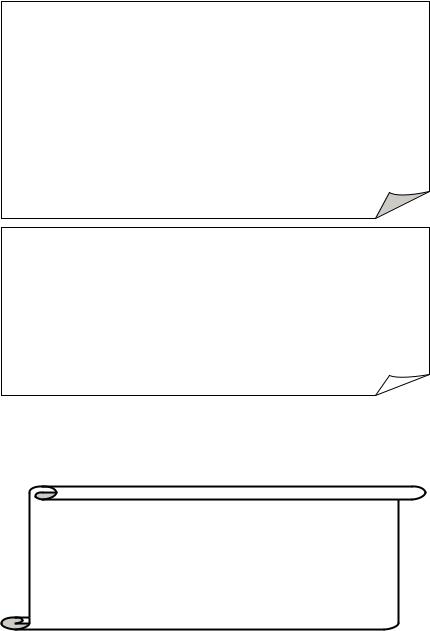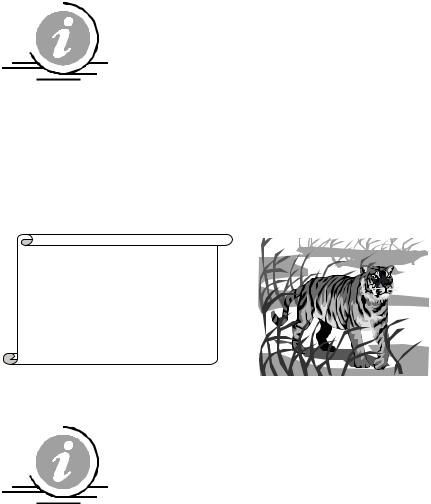
lavrova_n_a_a_coursebook_on_english_lexicology_angliiskaya_l
.pdf
problems. It was careless of you to leave the gas turned on – there could have been an explosion.
9.Have you heard about the infamous massacre of the innocents? The man was infamous in the vicinity for his extremist views. The writer is ill-reputed for making indecent allusions in his book. Our guide said that we should avoid the disreputable pat of the city.
10.The woman criticized her husband for being insensitive about her predicament. After the leader’s callous disregard of the soldiers’ plea to retreat, a riot ensued. The suit is insensitive to radiation.
11.A gullible man is easily taken in. Credulous citizens should be put wise as to the means that some con-men use to wiggle money out of them.
III
Read the following texts. Choose the right word for each context to complete the text below.
If you are invited to remain/to stay/to linger some time in the court of a great lord, you will end up spending a lot of time standing/staying/posing around. When this happens, do not sit down until the most important person present gives you permission/allowance/authorization/green light to do so. This is not necessarily the lord; if the king or queen or any other superior is visiting/attending/ frequenting the same house, and is present, then the social courtesies/politenesses/pleasantries/
endearments of rank are automatically due to the king or queen, not the man whose house this is. If a man who is superior/higher/more advanced in rank to you enters, move back and make room for him to stand nearer the lord or lady than you. When doing all this standing around do not let your eyes wander/travel/distract around the room [I. Mortimer, “The Time Traveller’s Guide to Medieval England”, 2007, P. 89].
101

One other contribution/input/share to the English vocabulary from Gulliver’s Travels is Lilliputian, meaning miniature. Many who have never made it to Book IV still have enjoyed Book I, where Gulliver finds himself shipwrecked/forlorn/devastated/run aground on an island where everyone and everything is one-twelfth his size… That Lilliputian term and most of the other words from the languages Gulliver encounters/meets…remain within the covers of the book. But because Gulliver’s story of Lilliput is so well-known/illustrious/ reputable, Lilliputian has entered/penetrated our vocabulary; and yahoo is so successful that it is known even among those who have no knowledge of Swift’s book [A. Metcalf, “Predicting New Words”, 2002, P. 57].
Though speech input/contribution is necessary for speech development/evolution, a mere soundtrack is not sufficient. Deaf parents of hearing children were once advised to have the children watch a lot of television. In no case did the children learn/study/acquire English. Without already knowing the language, it is difficult for a child to figure out/make out/discern what the characters in those odd, unresponsive televised worlds are talking about. Live human speakers tend/try/strive to talk about the here and now in the presence of children [S. Pinker, “The Language Instinct”, 1994, P. 278]. 
IV
Find the dominant synonym and name the type of connotation by which synonyms below differ. In what context would you use each of the synonyms?:
Brave – courageous – valiant – bold – fearless – intrepid; stupid – dim – dazed – slow – witted;
talkative – verbose – loquacious – eloquent – voluble; clever – intelligent – sensible – sagacious – acute – wise; merry – lively – jolly – cheerful – jovial – cheery – joyous; sad – mournful – doleful – wistful – grievous – dismal – rueful.
102

to respect – to esteem – to revere – to honour; to fight – to knock – to hit – to strike;
to live – to dwell – to reside – to subsist;
to eat – to consume – to devour – gobble – gorge – sup – wolf; expose – uncover – bare – disclose – divulge – reveal – unveil.
clothes – apparel – garment;
stoutness – corpulence – plumpness – obesity;
illness – sickness – disease – ailment – malady – malaise; noise – murmur – roar – din – uproar – hubbub – racket– clamour.
Antonyms are words of the same part of speech but with contrastive meanings. Traditionally, the following types of antonyms are distinguished (H. Jackson, E. Zé Amvela): gradable, contradictory (complementary), and converses.
gradable:
beautiful – ugly; expensive – cheap; fast – slow; hot – cold; increase – decrease; long – short; love – hate; rich – poor; sweet – sour; wide – narrow. They are called “gradable” because they represent a continuum on a scale and consequently allow comparison, for example: My hair is longer /shorter than yours. I love a good book more than I love a good newspaper. These adjectives can be modified by “intensifying” adverbs: very long, extremely hot, extraordinary beautiful. They do not represent absolute values.
contradictory (complementary):
asleep – awake; dead – alive; on – off; permit – forbid; remember – forget; shut – open; true – false; win – lose. These antonyms are in the relation of oppositeness: one state excludes the other: if you lose a contest, then you do not win it; being alive is incompatible with being dead.
converse antonyms:
above – below; before – after; behind – in front of; buy – sell; give – receive; husband – wife; parent – child; speak – listen.
103

Each word in these pairs of antonyms expresses the converse meaning of the other. In the case of sentences with, for instance, “buy” and “sell” the same transaction is expressed from different perspectives: e.g. I bought the flowers from Mary. – Mark sold me the flowers. Similarly, with the nouns “husband” and “wife”, a sentence may express the relationship in converse ways: e.g. Helen is John’s wife – John is Helen’s husband.
The same is true for prepositions like “above” and “below”: The semolina is on the shelf above the buckwheat. – The buckwheat is on the shelf below the semolina.
V
Distinguish between gradable, contradictory and converse antonyms:
light – dark; clever – stupid; early – late; to move – to stand; pure – contaminated; to go – to come; to leave – to arrive; a teacher – a pupil.
VI
Find the hyperonym for the following words. Under what heading can the words be subsumed:
1.Tongs, pliers, tweezers
2.Vest, half-slip, full-slip, camisole, chemise
3.Earmuffs, mittens, windbreaker
4.Lapel, shoelace, hem
5.Striped, checked, polka dot, solid, print, plaid
6.Right tackle, flanker, quarterback
VII
Choose the odd one out:
1.Swings, seesaw, slide, teeter
2.Pickaxe, sledgehammer, shovel, scaffolding
3.Stingray, flounder, swordfish, sea horse
4.Cut, bruise, burn, rickets
5.Stapler, paper clips, staple remover, pencil sharpener
6. Cashews, peanuts, walnuts, hazelnuts, almonds, chestnuts
104

The general names for a group of objects or animate beings are not always easy to learn or to remember. Apart from such recurring names as “a school (or shoal) of fish”, “a flock of birds”, “a clutch of eggs”, there are a number of less well-known, such as “bale”, “bevy”, “drove”, “exaltation”, “parliament”, “pride”.
VIII
Specify which groups of animals the following general words refer to:
A bale of |
tigers |
|
A bevy of |
larks |
|
A drove of |
owls |
|
An exaltation of |
quail |
|
A parliament of |
oxen |
|
A pride of |
turtles |
|
|
|
|
IX
The semantic relation of meronymy can be represented by a hierarchy of superordinate and subordinate terms, but, unlike the relationship of hyponymy, which is a “ ‘kind of’ relationship”, meronymy is the “ ‘part of’ relation”. In the case of meronymy the superordinate term is not a more general way of talking about its meronyms, rather, it represents an
entity in its totality. The parts of the entity are its meronyms, and they make up the whole.
Study the examples below and specify which type of semantic relationship is observed between the words – that of hyponymy or that of meronymy. Translate all the words into Russian.
105

spice cinnamon cloves parsley dill
basil bay leaf ginger
fabric silk chintz velvet crepe-de- chine corduroy
garment |
garment |
cook |
|
seam |
|||
frock |
boil |
||
hem |
|||
dress |
stew |
||
lining |
|||
cape |
fry |
||
lapel |
|||
tunic |
roast |
||
|
|||
gown |
|
simmer |
|
grill |
|
feeling |
poach |
|
braise |
||
premonition |
||
|
||
anticipation |
|
|
foreboding |
|
|
prescience |
|
mushroom
fly agaric (death cap)
toadstool chanterelle brown cap boletus
orange cap boletus (aspen mushroom) cep boletus (squirrel’s bread)
glasses earpiece arm lens bridge hinge frame
church altar choir nave transept crypt vault
Recommended reading:
Антрушина Г.Б., Афанасьева О.В., Морозова Н.Н. Лексикология английского языка: English Lexicology. – М.: Дрофа, 2004.
Арнольд И.В. Лексикология современного английского языка. – М.: Высш. шк., 1973.
106
Гальперин И.Р. Очерки по стилистике английского языка. – М.: Изд-во литературы на иностранных языках, 1958.
Гальперин И.Р. Лингвостилистика. – М.: Прогресс, 1980. Харитончик З.А. Лексикология английского языка: учеб. пособие. –
Минск: Выш. шк., 1992.
Cruse A. Meaning in Language. An Introduction to Semantics and Pragmatics. – Oxford; N.Y.: Oxford University Press, 2009.
Harrison M. Word Perfect. Vocabulary for Fluency. – Edinburgh: Nelson, 1990.

7. Phraseology
Points to ponder
–What criteria are applied in singling out phraseological units?
–In what way does a phraseological unit differ from a word, a free word-combination, a sentence?
–Are the terms “phraseological unit” and “idiom” synonymous? How is phraseology defined in Western linguistic tradition?
–Elaborate on the various types of classification of phraseological units.
–How does a person speak if he speaks “idiomatic English”? Does it imply that he/she necessarily uses a lot of phraseological units?
–How are the notions of metaphor, slang and phraseological units connected?
–What is the relationship between phraseological units and proverbs?
–Why does a writer sometimes choose to transform phraseological units? What effect does it produce?
–What are the sources of phraseological units? How do they originate?
–What is a terminological phraseological unit (терминологизм)?
In linguistic tradition there exist broad and narrow understanding of phraseology. In the narrow sense of the term, phraseology forms part of lexicology and focuses on fixed and semi-fixed word-com- binations that are characterized by the nominative function and whose meanings are partially or completely transferred. In the broad sense of the term,
phraseology is an independent discipline whose realm of study, tasks and goals were described by Prof. A.V. Kunin. Phraseological units are examples of secondary nomination: their meaning emerges on the basis of
108
metaphoric and/or metonymic transference. The salient features of phraseological units comprise expressivity and evaluation, structural stability and pre-fabricated nature: every time the need for their usage arises, they are not created out of the inventory of linguistic units, but are retrieved from the long-term memory as a whole unit that has a unique structure and meaning.
An all-embracing classification of phraseological units was worked out by Academician V.V. Vinogradov. This classification is based on the degree of semantic fusion of the components. Hence, the terms for each of the three subgroups:
1.Phraseological fusions are characterized by a complete transference of meaning, absolute structural stability and are demotivated. It means that tracing their etymology presents a challenge even to etymological dictionaries: the cat’s whiskers and the bee’s knees, at sixes and sevens, etc.
2.Phraseological unities are also characterized by transference of meaning and structural stability. However, they are clearly motivated: to keep one’s card close to one’s chest, to bark up the wrong tree, to be a slowcoach, to be quick off the mark, etc.
3.Phraseological combinations are less stable, transparent in meaning, and one of its components is used in the direct sense: to take
advantage, to lose hope, to have a walk, etc.
There exist a number of synonymic terms of the expression “phraseological unit”, such as: set expressions, set phrases, fixed word-groups, collocations.
In Russian linguistic tradition the preference is given to the term “phraseological unit”, whereas western scholars usually use the term “idiom”, which is broader in meaning, however, and can be defined as, first, “a phrase which means something different from the meanings of the separate words from which it is formed, and, second, “the way of expression typical of a person or a group in their use of language” [Longman Dictionary of English Language and Culture, 1993:655]. Hence, one can say the idiom of the young, the idiom of popular music, etc.
109

Exercises:
I
Specify the function the following proverbs and sayings perform. Explain what they mean in English and/or find their Russian equivalent.
1.Don’t count your chickens before they are hatched.
2.One swallow does not make a summer.
3.Don’t cross your bridges before you come to them.
4.After dinner sit a while, after supper walk a mile.
5.All are good lasses, but whence come the bad wives?
6.Ask no questions and you will be told no lies
7.Better a lean peace than a fat victory
8.A cock is valiant on his own dunghill.
9.Empty vessels make the greatest sound.
10.He that has no children knows not what love is.
11.He that will not when he may, when he will he shall
have nay
II
Construct a proverb from the given constituents:
1.would, the fruit, climb, that, eat, must, the tree, he
____________________________________________
2.is, policy, honesty, the best
____________________________________________
3.bad, is, a, supper, breakfast, but, a, hope, good
____________________________________________
4.mud, you, enough, of it, will, stick, if, throw, some
____________________________________________
5.is, with, bait, is, a, silly, that, twice, the, fish, same, it, caught
____________________________________________
6.think, sheep, heavy, lazy, its, wool
____________________________________________
7.heavy, makes, a, heart, light, purse
____________________________________________
III
110
